NVIDIA GeForce GTX 760 Review: The New Enthusiast Kepler
by Ryan Smith on June 25, 2013 9:00 AM ESTPower, Temperature, & Noise
As always, last but not least is our look at power, temperature, and noise. Next to price and performance of course, these are some of the most important aspects of a GPU, due in large part to the impact of noise. All things considered, a loud card is undesirable unless there’s a sufficiently good reason – or sufficiently good performance – to ignore the noise.
With both the 600 series GK104 parts and the GK104 based GTX 770 as a backdrop here, we’re not expecting any great surprises here. Power consumption is going to approach the GTX 670 thanks to GPU Boost 2.0 and the identical TDPs. And since the cooler is also the same, acoustics should also be similar. Only idle power should show any real variation.
| GeForce GTX 760 Voltages | ||||
| GTX 770 Max Boost | GTX 760 Max Boost | GTX 770 Idle | ||
| 1.2v | 1.2v | 0.850v | ||
Like the GTX 770, GTX 760 is spec’d to a stock top voltage of 1.2v. This buys NVIDIA the 1100MHz+ clockspeeds we’re seeing, but it drives up power consumption.
| GeForce GTX 760 Average Clockspeeds | |||
| Max Boost Clock | 1149MHz | ||
| DiRT:S |
1134MHz
|
||
| Shogun 2 |
1127MHz
|
||
| Hitman |
1149MHz
|
||
| Sleeping Dogs |
1139MHz
|
||
| Crysis |
1145MHz
|
||
| Far Cry 3 |
1132MHz
|
||
| Battlefield 3 |
1123MHz
|
||
| Civilization V |
1139MHz
|
||
| Bioshock Infinite |
1131MHz
|
||
| Crysis 3 |
1105MHz
|
||
Looking at the average clockspeeds among our games, despite the official 1033MHz boost clock for GTX 760 always boosts to an average over 1100MHz, with most games boosting to around 1130MHz. The limiting factor here is typically temperatures, which quickly hit 80C at the highest boost bin and its 1.2v operating voltage. A card with a better cooler would likely have no trouble sustaining 1149MHz here.
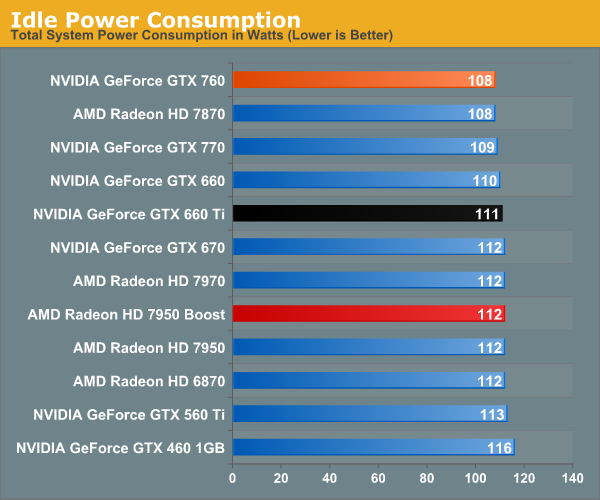
As we saw with the GTX 770 a few weeks ago, NVIDIA’s idle power consumption as measured at the wall has come down a couple of watts compared to the older GK104 cards. With a lower idle clockspeed compared to the GTX 660 Ti and its ilk, NVIDIA has been able to shave off that wattage without any more substaintial changes. However I continue to be surprised that we’re seeing any difference between the GTX 760 and the 7950B, as AMD is no slouch here either.
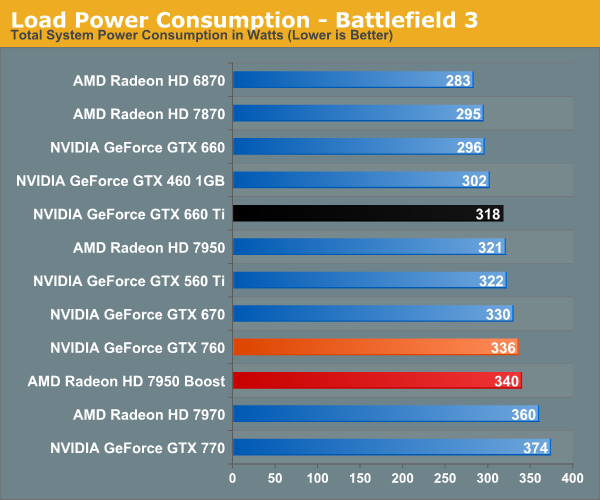
Moving on to load power under Battlefield 3, our results validate our earlier theories on power consumption based on the spec sheets. Wall power with a GTX 760 is 6W higher than GTX 670 in this test, and 18W higher than with a GTX 660 Ti. There’s no getting around the fact that GTX 670-like performance requires GTX 670-like power consumption.
At the same time the power consumption of the GTX 760 is almost identical to the 7950B at the wall. Though given the 7950B’s lower performance in this benchmark, what we’re actually seeing is lower CPU power consumption offsetting the 7950B’s higher power consumption.
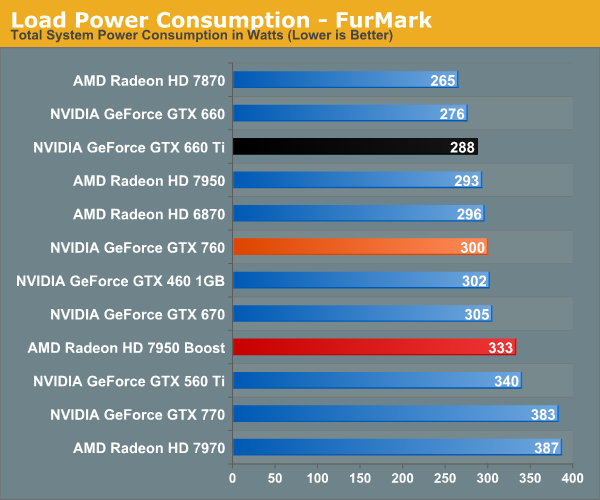
With Furmark the story is fairly similar for the NVIDIA cards, all of which come close together due to their similar TDPs. Meanwhile the 7950B pulls about 30W more at the wall, in-line with its 200W TDP. NVIDIA edged out AMD on power efficiency with the 600 series, and we’re going to see the same thing on the 700 series.
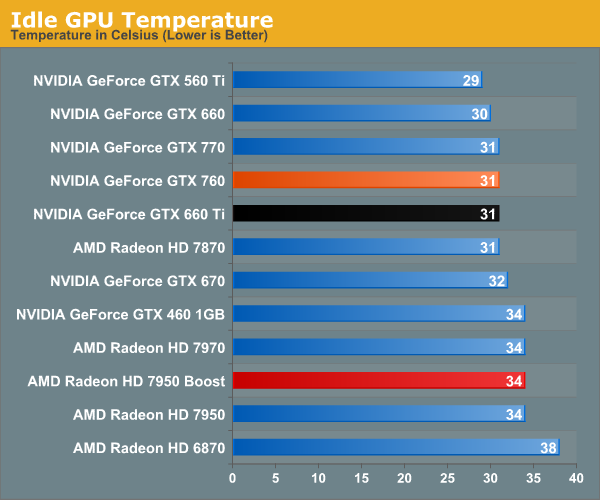
Based on the same cooler and GPU as the GTX 670, the GTX 760 offers no grand revelations here. 31C is standard for this type of blower cooler.
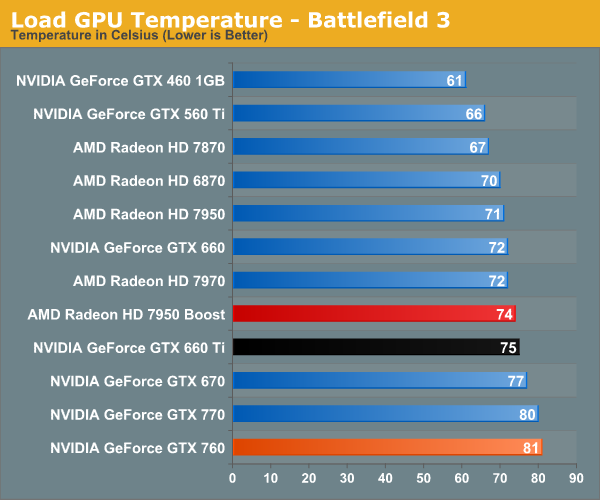
Even though the GTX 760 and GTX 670 have identical TDPs, the presence of GPU Boost 2.0 means that the GTX 760 operates nearer its TDP more often, and in this case the 80C throttle imposed by GPU Boost makes itself felt. 81C does end up being the worst among the cards in this collection, but it’s a reasonable temperature for a GK104 GPU, to the point where in temperature limited scenarios this is exactly where it’s designed to top out at.

With FurMark our results are much the same as with BF3. The slower response time of the fans on the GTX 770 and GTX 760 mean that both cards top out at 82C before temperatures level out, a few degrees warmer than with the GTX 670 and GTX 660 Ti. Alternatively the 7950B and its more powerful fan keep temperatures at or below 75C for any workload we throw at it.
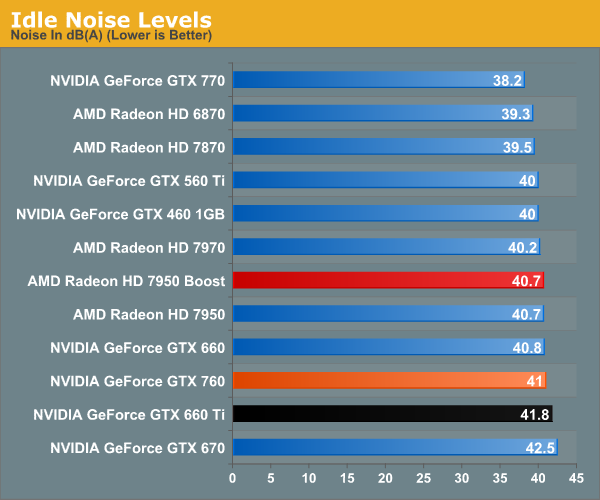
Since NVIDIA used the same cooler/fan assembly as on the GTX 670, the GTX 760 is going to give us similar acoustics. Unfortunately that includes the characteristic faint grinding noise that we’re previously mentioned. Idle noises as a result are respectable, but GTX 770 this is not.

Moving to fan noise under load, here we can see NVIDIA’s default fan curve and 80C throttle once again pay off. The GTX 760 hits 50dB under BF3, which for this specific cooler is actually doing a bit better than average, as evidenced by the slight advantage the GTX 760 has over the GTX 670. The GTX 770 and Fermi cards are something of spoilers here though, a reminder of what the Titan cooler and open air cooling can do. We will have some custom GTX 760s next week, so it will be interesting to see how much better these cards are when it comes to noise. 50dB is by no means bad, especially for the performance, but at this point we’ve seen lower noise levels out of cards with similar price tags and TDPs.
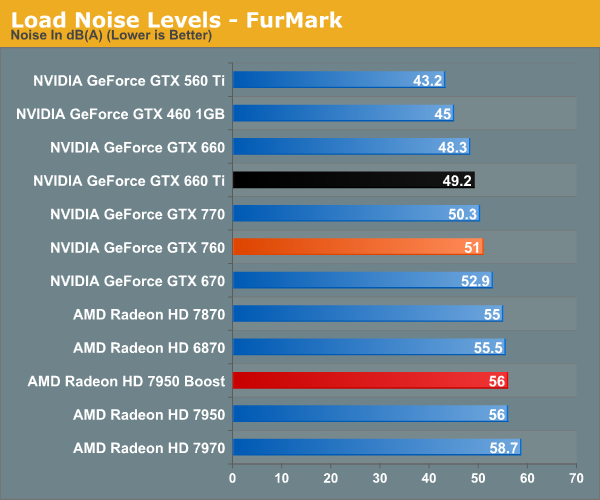
Finally, FurMark once again paints a picture very similar to what we saw with Battlefield 3. For NVIDIA cards this is middle of the road, while at 5dB quieter than the reference 7950B it’s a significant improvement.










110 Comments
View All Comments
Ryan Smith - Tuesday, June 25, 2013 - link
Going by my chart, I have the GTX 760 winning in 7 of 10 games (all but DiRT, Hitman, and Crysis 1) at our highest 1080p quality settings, which is where I'm focusing on for a card this expensive. Of those magnitude matters; most of those GTX 760 wins are in the double digits, so the average does indeed end up being 8%As for frametimes, the idea is that we would normally include them. That said this review left us crunched for time; I would have likely needed to drop the Fermi cards to make time. With that in mind, there's absolutely nothing interesting going on with single-GPU frametimes right now with the games we use. The only place NVIDIA still differ are under multi-GPU scenarios.
Zstream - Tuesday, June 25, 2013 - link
Shouldn't we be using the median instead of average?ewood - Tuesday, June 25, 2013 - link
median, mean and mode all show very different things. you should have all three to draw detailed conclusions, however if only one is available i would personally prefer it be the mean.ShieTar - Thursday, June 27, 2013 - link
With a sample size of 10, the median would not be a very helpful information. To be honest, the mean is not all the important either. The distribution of performances is not all that random when comparing nVidia and AMD, but rather there are significant preferences for one architecture by each game.So everybody on the lookout for a new card should mainly be checking for a benchmark specifically on the game he/she spends the most time with. For this reason, I would love to see the benchmarks on Anandtech include the name of the engine for each game (if it is a licensed one), and maybe provide some handy reference to figure out what other games use the same reference.
And personally, as a player who does not play reaction-based games like shooters or racers a lot, I would love AT to re-introduce a BioWare and/or Blizzard title back into their benchmark-zoo. Even if those are not extremely new or demanding, I think they still have a high importance for a large number of players who don't care much to shoot virtual people in their virtual faces.
MarcVenice - Tuesday, June 25, 2013 - link
I see, I counted Sleeping Dogs as a win for the HD 7950 as well, considering the minimum fps is a bit higher. Thanks for the reply, I agree that if all is well with frametimes in a certain game, fraps is still a good way to measure raw rendering power.JeBarr - Tuesday, June 25, 2013 - link
Most multi-GPU users are reporting that the frame time issue mostly exists for 2-way SLI and Quad SLI. It seems that 3-way SLI or Dual GPU single slot SLI is the way to go for gamers concerned about the stutters. I'm not sure about 4-way SLI though, since I don't bother with it anymore. I can however, confirm that in my personal experience a single GPU or 3-way SLI is mostly unaffected.draknon - Tuesday, June 25, 2013 - link
This seems like a good spot to upgrade from my 460gtxEzioAs - Tuesday, June 25, 2013 - link
Yeah, it is. My original plan was to get the GTX 760, but Nvidia delayed it and I wasn't going to wait anymore, so I went and bought the GTX 660.DanNeely - Tuesday, June 25, 2013 - link
I'm tempted to upgrade to it from my 560 when I built a Haswell box later this summer and put the difference between it and a higher end card toward a better SSD, etc and then get a top end Maxwell based card next year.I'm a bit concerned about ending up in the same trap I did last time though. I bought the 560 as a stopgap replacement in Jan 2012 after stupidity killed my 5870, with the intent of upgrading to a GK100 based card in half a year or so only to have nVidia fumble its top end launch.
omarccx - Tuesday, June 25, 2013 - link
It seems like an even greater upgrade from my HD4000. :x